As autumn approaches, many gardeners instinctively reach for the familiar mums to fill their fall containers. While charming, mums offer a fleeting burst of color, often lasting only a few weeks before fading into dormancy. This seasonal approach means you constantly replace plants, which adds to your garden budget and can feel like a chore. If you are a small-space gardener or simply prefer a less demanding option, a more strategic choice exists.
Imagine a plant that delivers stunning, vibrant foliage through fall, maintains interest through winter, and then re-emerges with renewed vigor in spring. This hardworking perennial offers an incredible array of colors, textures, and forms, transforming your patio, balcony, or small yard into a gallery of lasting beauty. This unsung hero is Heuchera, commonly known as Coral Bells. It provides consistent, eye-catching appeal with minimal fuss, making it the perfect low-maintenance solution for your fall container displays. Let us explore why Heuchera deserves a prime spot in your autumn garden.
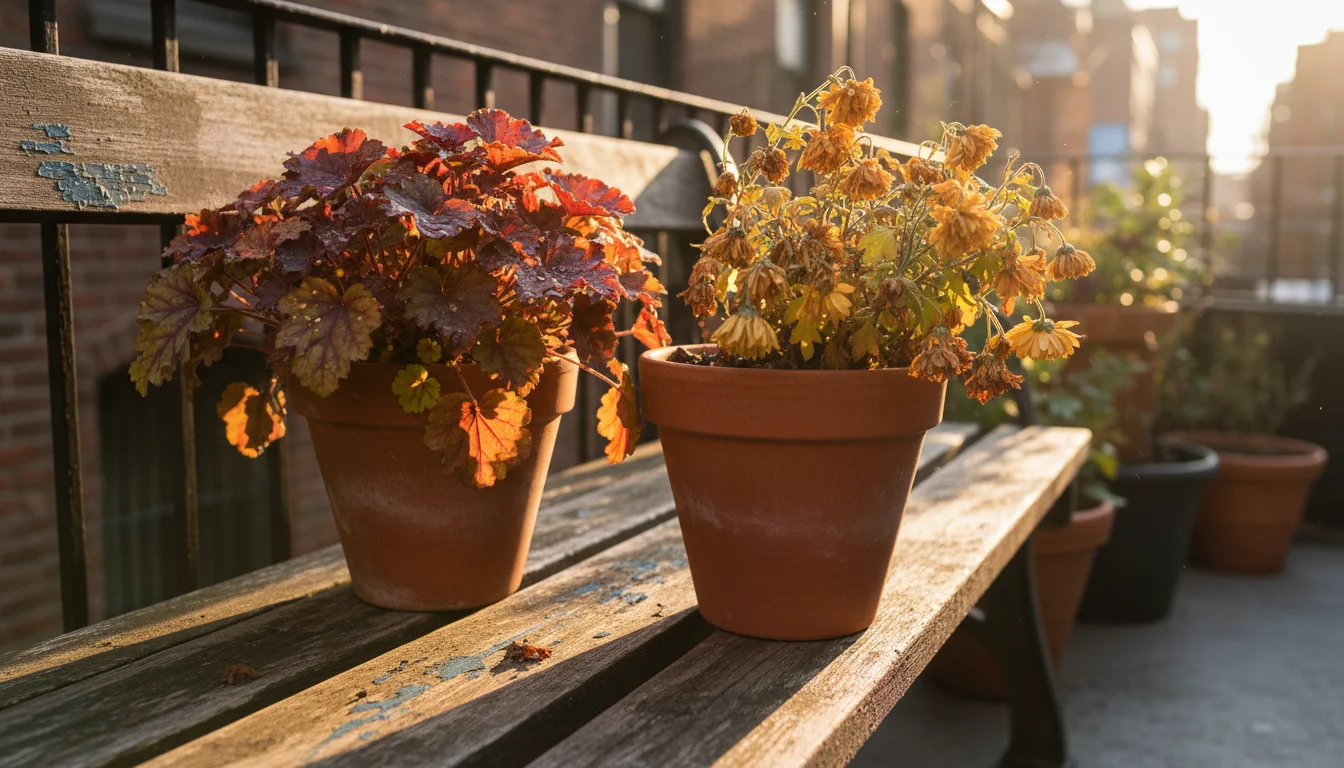
Why Heuchera Outshines Traditional Fall Container Plants
When you consider fall container options, you often see displays dominated by annuals like mums, ornamental kale, or pansies. While these provide immediate charm, they also come with inherent limitations, especially for gardeners seeking sustained beauty and practicality. Heuchera, with its many benefits, offers a compelling alternative.
Here is why Heuchera stands out:
- Multi-Season Interest, Not Just Fall: Mums typically bloom for a few weeks in autumn, then decline. Heuchera, a perennial, offers vibrant foliage from spring through winter in many climates. Its leaves provide color and texture for months, not just weeks, making your container displays dynamic and long-lasting.
- Foliage-First Beauty: While mums rely on flowers, Heuchera shines through its incredible leaf colors. You will find varieties in shades of crimson, plum, chartreuse, amber, silver, and even nearly black. These rich hues often intensify with cooler fall temperatures, providing a natural autumn spectacle without a single bloom. You get a consistent display of “fall foliage plants” that does not depend on a short blooming window.
- Low Maintenance: Many fall annuals require consistent watering and deadheading to look their best. “Coral bells care” in containers is remarkably straightforward. They are not heavy feeders, rarely suffer from serious pests or diseases, and tolerate a range of conditions. This makes them ideal for busy gardeners or those new to container planting.
- Cost-Effectiveness Over Time: Buying new annuals every season adds up. Investing in Heuchera means you purchase a plant once that can return for years. You can divide mature plants to create new ones, further increasing their value. This makes Heuchera an economical choice for sustainable gardening.
- Adaptability to Light Conditions: While many traditional fall plants demand full sun to thrive, many Heuchera varieties perform beautifully in partial to full shade. This versatility makes them excellent “low light plants for fall containers,” opening up design possibilities for shadier patios and balconies where other plants might struggle.
By choosing Heuchera, you elevate your fall containers beyond temporary decorations into enduring garden statements, providing extended enjoyment and reducing ongoing effort.
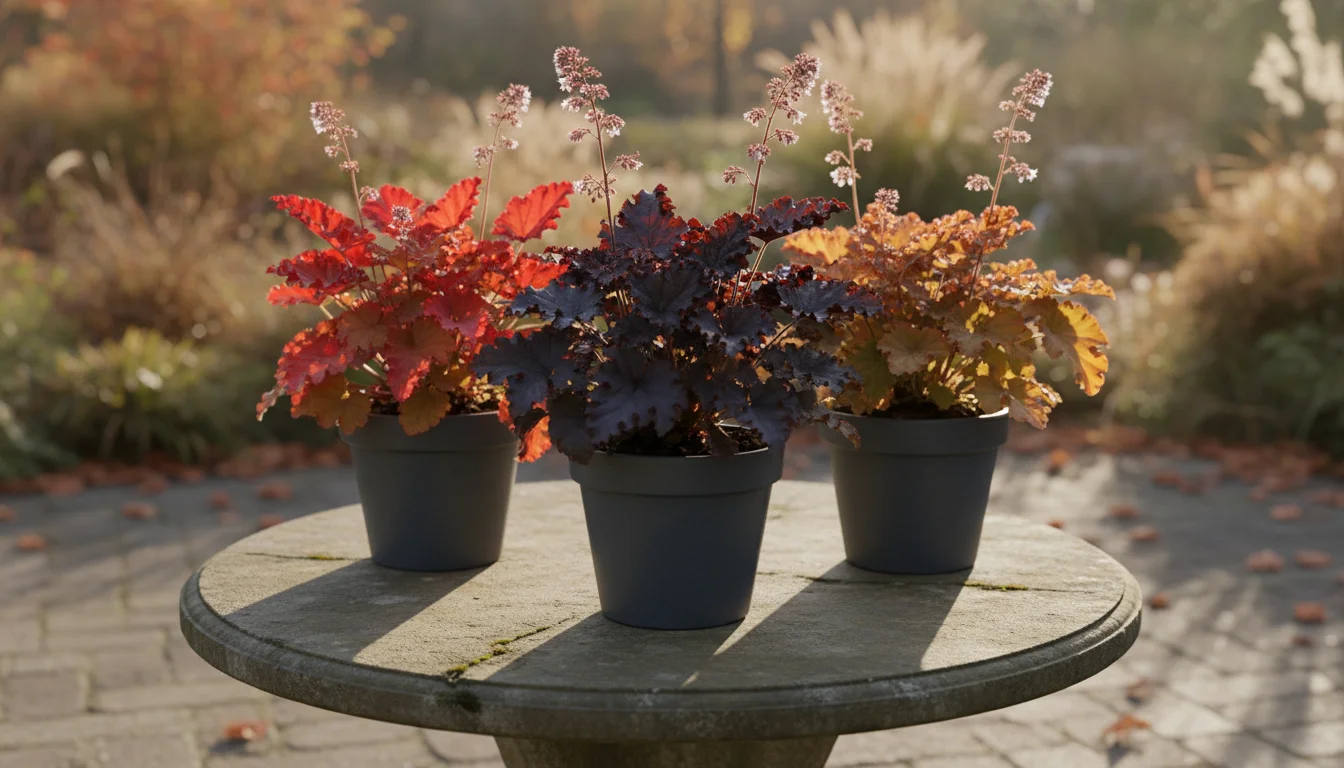
Understanding Heuchera: A Plant Built for Beauty and Resilience
Heuchera, also known as Coral Bells or Alumroot, belongs to the Saxifragaceae family. This genus includes numerous species and countless cultivars, each offering unique characteristics. Native to North America, these plants thrive in woodlands and rocky areas, which explains their inherent resilience and adaptability in garden settings. This natural hardiness translates directly into their low-maintenance appeal for home gardeners.
Heuchera’s primary appeal lies in its stunning foliage. Unlike many plants valued for their flowers, Coral Bells captivate with their leaves, which come in an astonishing spectrum of colors. You can find varieties with leaves in:
- Deep Reds and Burgundies: Varieties like ‘Obsidian’ or ‘Forever Purple’ provide dramatic, rich color.
- Vibrant Oranges and Ambers: ‘Marmalade’ or ‘Caramel’ offer warm, glowing tones that perfectly complement autumn decor.
- Bright Limes and Chartreuse: ‘Lime Rickey’ or ‘Electric Lime’ bring a burst of light to shady spots.
- Silvers and Pewters: ‘Silver Gumdrop’ or ‘Palace Purple’ (older variety but still popular) feature metallic sheens and intricate veining.
- Variegated Patterns: Some varieties display contrasting veins or blotches, adding even more visual interest.
Beyond color, leaf shapes and textures also vary widely, from smooth and glossy to ruffled and deeply lobed, often with a velvety or crinkled appearance. This diversity allows you to create complex and engaging container designs using Heuchera alone or in combination with other plants.
While foliage takes center stage, Heuchera also produces delicate flower spikes in late spring or early summer. These tiny, bell-shaped flowers, typically in white, pink, or red, attract hummingbirds and other pollinators. However, for most container applications, you select Heuchera for its enduring foliage. The flowers are a bonus, contributing to the plant’s overall charm and ecological value.
When we discuss “drainage” for container plants, we refer to how efficiently water moves through the soil and out of the pot. Heuchera requires well-draining soil to prevent its roots from sitting in water, which can lead to root rot. Their natural habitat often includes rocky, sloped areas, which inherently provide good drainage, demonstrating this vital need.

Choosing the Right Heuchera Varieties for Your Fall Containers
Selecting the perfect Heuchera for your containers involves considering color, texture, and the specific light conditions of your planting site. With hundreds of cultivars available, you have an abundance of choices. Here are some guidelines and popular varieties to help you make your selection:
Consider Your Light Conditions:
- Full Sun (6+ hours direct sun daily): In cooler climates, some Heuchera can tolerate more sun, especially if soil moisture is consistent. Look for varieties with darker foliage, as these often handle more sun exposure without scorching. Examples include ‘Obsidian’ or ‘Forever Purple’.
- Partial Shade (3-6 hours direct sun, often morning sun): Most Heuchera thrive in partial shade. This condition often brings out the best foliage color and prevents leaf scorch. This is the ideal situation for “heuchera in containers.”
- Full Shade (less than 3 hours direct sun daily): Lighter green or yellow varieties tend to perform well in full shade, brightening darker spots. ‘Lime Rickey’ or ‘Electric Lime’ are excellent choices for “low light plants for fall containers.”
Color and Texture Combinations:
Think about how different Heuchera varieties will look together or with other plants in your container. Contrast is key for visual interest.
- Dramatic Dark Tones:
- ‘Obsidian’: Features incredibly dark, almost black, glossy leaves. It provides a sophisticated backdrop or a dramatic focal point.
- ‘Black Pearl’: Similar to ‘Obsidian’ but with a slightly more ruffled texture and often a stronger sheen.
- ‘Forever Purple’: Boasts deep purple, intensely ruffled leaves that maintain their color well through the seasons.
- Warm Autumn Hues:
- ‘Marmalade’: Known for its wavy, coppery-orange leaves with a deep pink-purple underside. The colors shift beautifully with temperature changes, making it a standout “fall foliage plant.”
- ‘Caramel’: Offers glowing amber to apricot-orange leaves. It tolerates heat and humidity well.
- ‘Ginger Ale’: Displays soft ginger-yellow leaves with a slight silver overlay.
- Bright and Bold Accents:
- ‘Lime Rickey’: Features bright, glowing chartreuse green leaves that brighten any shady spot.
- ‘Electric Lime’: A vibrant lime green variety with deeply cut, ruffled foliage.
- Silvery and Intricate Patterns:
- ‘Silver Gumdrop’: Offers shiny, silver-frosted leaves with dark veins.
- ‘Palace Purple’: A classic, older variety with deep bronze-purple foliage that often has a silvery sheen. It is known for its hardiness.
When you select varieties, always check the mature size listed on the plant tag. Some Heuchera grow into substantial mounds, while others remain more compact. For containers, choosing varieties that fit your pot size and design vision ensures a balanced and attractive display.

Planting Heuchera in Containers: Step-by-Step Success
Proper planting sets the stage for a thriving Heuchera display. These steps ensure your “heuchera in containers” gets the best possible start.
Step 1: Choose the Right Container
- Size Matters: Select a container that is at least 10-12 inches in diameter for a single Heuchera, or larger if you plan to combine multiple plants or varieties. A larger pot offers more soil volume, which means more stable moisture and temperature for the roots.
- Drainage Holes Are Non-Negotiable: Heuchera absolutely requires excellent drainage. Ensure your chosen pot has drainage holes at the bottom. Without them, water accumulates, leading to root rot.
- Material Considerations: Terracotta pots look classic and allow some moisture to evaporate through their walls, which can be beneficial but also means more frequent watering. Plastic or glazed ceramic pots retain moisture longer, which might be preferable in hot climates or if you tend to forget watering.
Step 2: Select High-Quality Potting Mix
- Avoid Garden Soil: Never use garden soil in containers. It compacts easily, drains poorly, and can introduce pests and diseases.
- Opt for Potting Mix: Choose a premium, well-draining potting mix. A good mix provides adequate aeration, holds moisture without becoming waterlogged, and offers essential nutrients. You can enhance drainage further by mixing in a small amount of perlite or coarse sand, but most quality potting mixes are already formulated for container use.
Step 3: Prepare Your Pot
- Place a piece of landscape fabric or a coffee filter over the drainage holes. This prevents soil from washing out while still allowing water to escape. Avoid using gravel or pottery shards at the bottom; this can actually hinder drainage, creating a “perched water table” where water accumulates just above the gravel layer.
- Fill the container about one-third to halfway with your chosen potting mix.
Step 4: Remove the Heuchera from its Nursery Pot
- Gently squeeze the sides of the nursery pot and carefully slide the plant out. If the roots are circling tightly at the bottom (root-bound), gently tease them apart with your fingers. This encourages them to grow outwards into the new soil.
Step 5: Position the Plant
- Place the Heuchera in the center of your container. Ensure the crown of the plant (where the stems meet the roots) sits at or just slightly above the soil line. Planting too deep can lead to crown rot, a common issue for Heuchera if not planted correctly.
Step 6: Fill and Firm the Soil
- Add more potting mix around the root ball, filling the pot to about one inch below the rim. This leaves space for watering without overflow.
- Gently firm the soil around the plant with your hands. Avoid compacting it too tightly, as this can impede root growth and drainage.
Step 7: Water Thoroughly
- After planting, water your Heuchera deeply until water drains from the bottom of the pot. This settles the soil around the roots and eliminates air pockets.
- Monitor moisture closely for the first few weeks, as the plant establishes itself in its new home.
By following these simple steps, you provide your Heuchera with an optimal environment for growth, ensuring it thrives and delivers consistent beauty in your fall containers.

Ongoing Coral Bells Care: Keeping Your Fall Display Vibrant
One of Heuchera’s most attractive qualities is its relatively low maintenance. However, understanding a few key aspects of “coral bells care” in containers helps ensure your plants remain healthy and vibrant throughout the seasons.
Light Requirements:
Heuchera performs best in partial shade, meaning it thrives with a few hours of morning sun and protection from intense afternoon heat. In deeply shaded areas, varieties with lighter foliage (lime green, chartreuse) often maintain better color and vigor. In cooler climates, or if you provide consistent moisture, many varieties tolerate more sun. Too much direct, hot sun can cause the leaves to scorch or fade, especially for varieties with intricate colors. If you notice leaf edges browning or colors dulling, move your “heuchera in containers” to a shadier spot. Their adaptability makes them excellent “low light plants for fall containers” in many settings.
Watering:
Consistent moisture is crucial for Heuchera in containers. Containers dry out faster than garden beds, so you must monitor soil moisture regularly. Water your Heuchera when the top inch of soil feels dry to the touch. Water deeply until you see water draining from the bottom of the pot. Avoid letting the pot sit in standing water, as this leads to root rot. During active growth in spring and summer, you might water every few days, depending on weather conditions. As fall progresses and temperatures drop, reduce watering frequency, allowing the soil to dry out slightly more between waterings.
Fertilizing:
Heuchera are not heavy feeders. For “heuchera in containers,” a single application of a balanced, slow-release granular fertilizer in early spring is usually sufficient. Alternatively, you can use a diluted liquid fertilizer once a month during spring and early summer. Avoid over-fertilizing, as this can lead to lush, leggy growth at the expense of vibrant foliage color, and it can also burn the roots. Many potting mixes already contain some nutrients, so often, less is more.
Pest and Disease Management:
Heuchera are generally quite resilient to pests and diseases. The most common issues you might encounter include:
- Slugs and Snails: These pests sometimes chew holes in the leaves, especially in moist conditions. You can hand-pick them, set beer traps, or use organic slug baits.
- Root Rot: The primary enemy of Heuchera. It results from overwatering or poor drainage. Ensure your pot has drainage holes and your soil drains well.
- Rust and Powdery Mildew: Fungal issues that can appear in humid, crowded conditions. Ensure good air circulation around your plants and avoid overhead watering. Remove and discard affected leaves promptly.
Deadheading and Grooming:
While Heuchera’s flowers are not its main attraction, you can deadhead (remove spent flower stalks) once they fade. This redirects the plant’s energy into producing more vigorous foliage, which is exactly what you want for a “fall foliage plant.” Throughout the year, remove any yellowed, damaged, or unsightly leaves by gently tugging them from the base. This keeps your plant looking tidy and healthy.
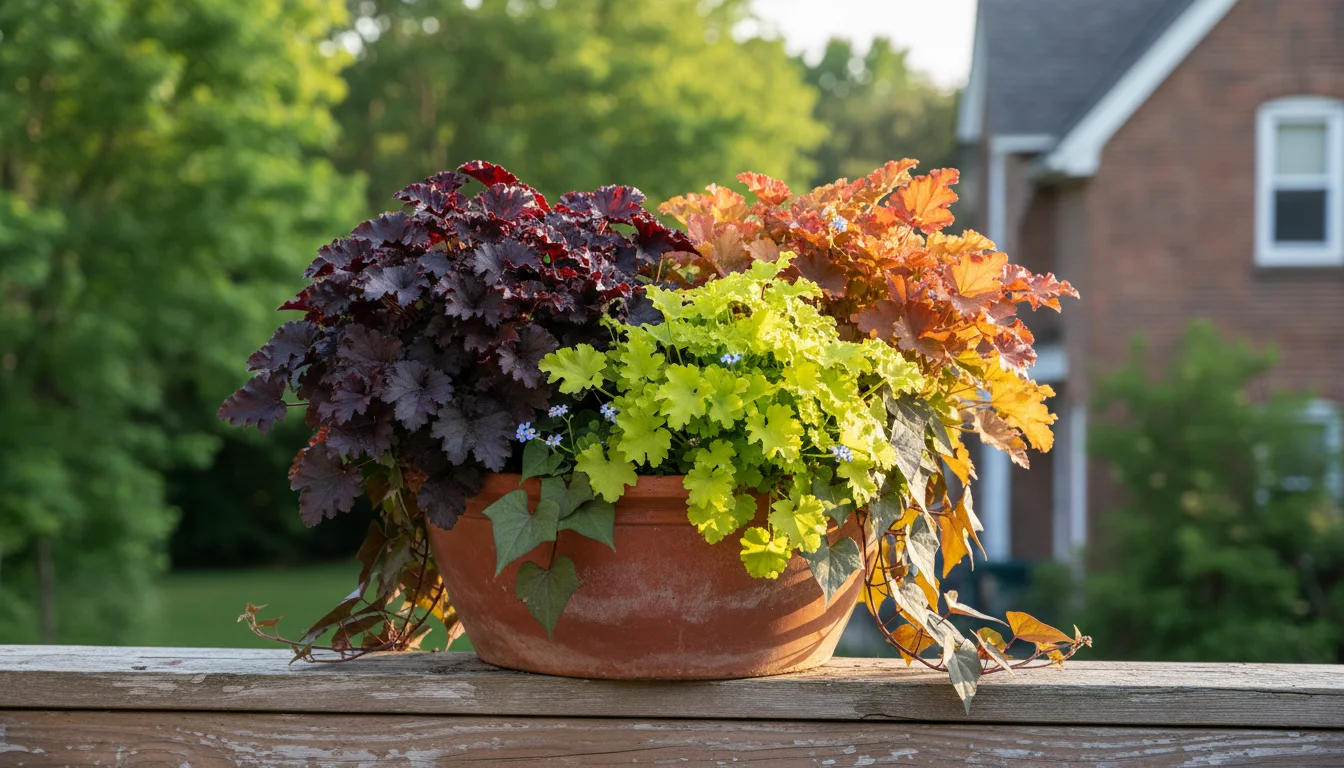
Designing with Heuchera: Creative Combinations for Small Spaces
Heuchera’s exceptional range of foliage colors and textures makes it a designer’s dream, especially for small-space gardeners. You can create striking combinations that offer multi-season appeal. Think of Heuchera as the ultimate “filler” or “thriller” in your container designs, providing a strong foundation of color and form.
The Foliage-First Approach:
When designing with Heuchera, shift your focus from ephemeral flowers to the lasting impact of leaves. Combine different Heuchera varieties to create stunning contrasts. For example, pair a dark purple Heuchera like ‘Obsidian’ with a vibrant lime green ‘Lime Rickey’ for dramatic visual tension. Or, mix warm-toned varieties like ‘Marmalade’ and ‘Caramel’ for a fiery autumn display.
Thriller, Filler, Spiller for Fall:
This classic container design principle works beautifully with Heuchera, adapting it for fall and emphasizing foliage.
- Thriller (the vertical element): Choose something tall and upright for the center or back of your container.
- Ornamental Grasses: Small fountain grasses (e.g., ‘Hameln’), Sedges (Carex), or dwarf Miscanthus provide texture and movement.
- Dwarf Conifers: A slow-growing dwarf conifer offers year-round structure.
- ‘Autumn Fern’: Its upright, bronze-tinted fronds perfectly complement Heuchera.
- Filler (the body of the container): This is where Heuchera truly shines. Use one or more Heuchera varieties to fill out the middle ground, providing consistent color and texture.
- Pair a rich purple Heuchera with a silvery one for elegant contrast.
- Use a bright orange ‘Marmalade’ with contrasting dark ornamental kale or pansies.
- Spiller (the cascading element): Plants that trail over the edges of the pot add softness and completeness.
- Creeping Jenny (Lysimachia nummularia ‘Aurea’): Its bright chartreuse foliage cascades beautifully, echoing lighter Heuchera tones.
- Ivy (Hedera helix): A classic, durable spiller that offers evergreen texture.
- Vinca minor: Another reliable evergreen groundcover that trails elegantly.
- Sweet Potato Vine (Ipomoea batatas): While typically an annual, its vibrant foliage can last well into fall until the first hard frost, offering incredible color.
Specific Plant Pairing Suggestions for “Fall Foliage Plants”:
- Heuchera + Ornamental Grasses + Pansies: A dark Heuchera (‘Obsidian’) as the filler, a small fountain grass as the thriller, and cool-season pansies or violas for a touch of early bloom and color variety.
- Heuchera + Small Conifer + Creeping Jenny: A vibrant orange Heuchera (‘Marmalade’) surrounding a miniature spruce or juniper, with bright green creeping Jenny trailing over the edge. This provides excellent texture and multi-seasonal interest.
- Heuchera + Cyclamen + Ivy: For shadier spots, combine a silver-leaved Heuchera (‘Silver Gumdrop’) with cheerful cyclamen (which blooms in cool weather) and a trailing variegated ivy for a sophisticated yet lively display.
- Heuchera + Coral Bells + Coral Bells: Do not underestimate the power of combining different Heuchera varieties in one pot. A trio of contrasting colors, like deep red, bright lime, and amber, creates a stunning tapestry of “fall foliage plants.”
When planning your container, consider the overall color scheme and the light conditions of your chosen spot. Heuchera’s versatility allows you to create captivating, low-maintenance containers that truly extend the beauty of your garden into the colder months.
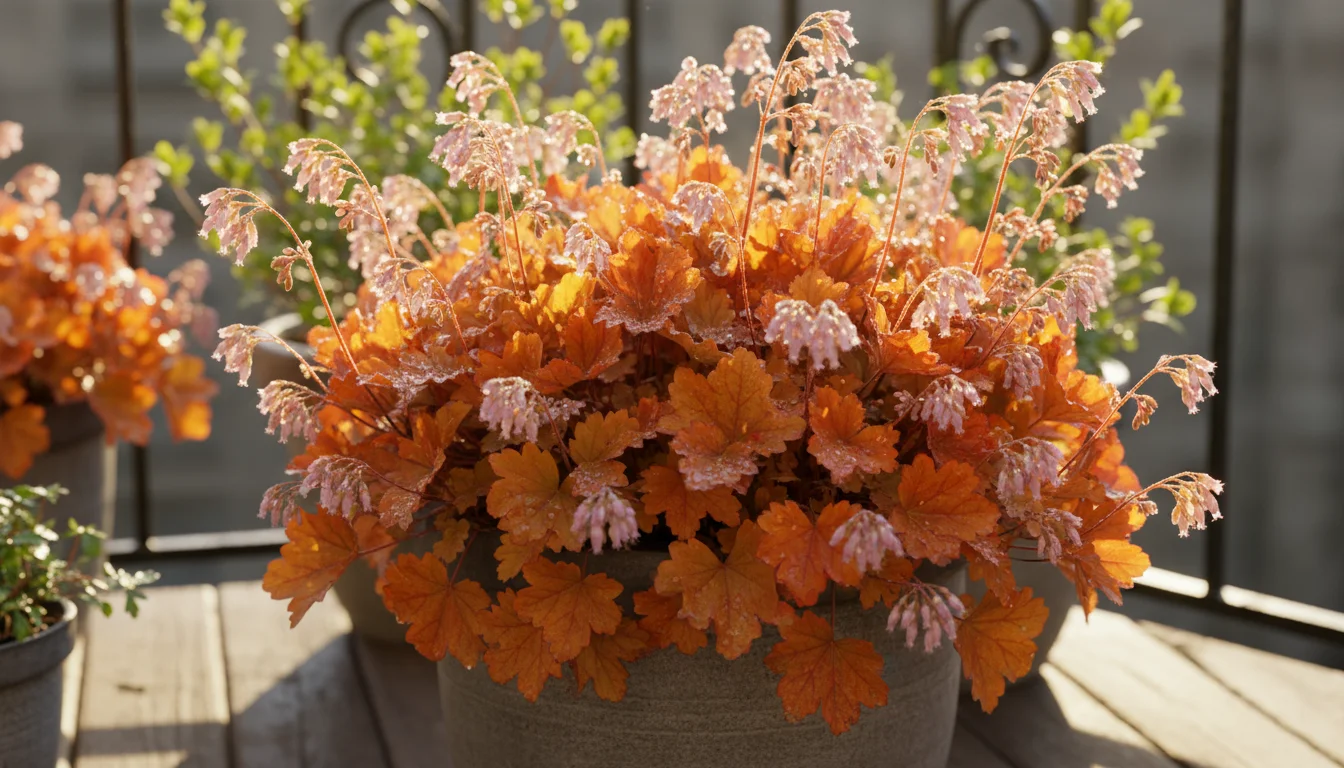
Heuchera Through the Seasons: Enjoying Your Plants Year-Round
One of Heuchera’s most compelling attributes, especially for small-space and low-maintenance gardeners, is its multi-seasonal appeal. Unlike annuals that perform for one season and then disappear, Heuchera offers year-round interest. This longevity contributes to their value as “best perennials for fall color in pots” and beyond.
- Spring Awakening: As temperatures rise, your Heuchera plants burst with fresh, new growth. The foliage often appears in its most vibrant, jewel-toned hues. Many varieties send up delicate flower stalks in late spring or early summer, attracting hummingbirds and adding a subtle, airy touch to the container. This is a time of renewal and promise, as your “heuchera in containers” emerges from winter dormancy or semi-dormancy.
- Summer Splendor: Throughout the summer, Heuchera provides a reliable backdrop of color and texture. Its lush foliage remains consistent, forming attractive mounds. While intense summer sun can sometimes cause lighter-colored varieties to bleach or darker ones to scorch without adequate moisture, most Heuchera maintains its beauty in partial shade. They require consistent watering during the hotter months to prevent stress.
- Fall Foliage Fiesta: This is where Heuchera truly shines as a “fall foliage plant.” As autumn temperatures cool, many varieties’ colors deepen and intensify. The rich reds become richer, the bronzes more burnished, and the oranges more fiery. This extended display makes them far superior to short-lived annuals for autumn containers. Their presence extends the gardening season, adding warmth and visual delight to your outdoor spaces long after other plants have faded.
- Winter Resilience: In many temperate climates (USDA Zones 4-9, depending on variety and protection), Heuchera remains evergreen or semi-evergreen through winter. This means their beautiful foliage continues to provide texture and color even when snow falls or other plants go dormant. While the colors might become more muted in extreme cold, the structural presence of the plant offers invaluable interest during the bleakest months. This resilience makes them excellent candidates for “heuchera winter care in pots,” providing continuous enjoyment.
Embracing Heuchera means enjoying a continuous cycle of beauty and interest. You plant once, and the plant rewards you with an ever-changing display, season after season. This sustained performance makes them an eco-friendly and practical choice, reducing the need for constant replanting and providing enduring appeal.

Heuchera Winter Care in Pots: Protecting Your Perennials
While Heuchera are hardy perennials, those grown in containers require special attention during winter, especially in colder climates. Containerized plants expose their root systems to much colder temperatures than plants insulated by the surrounding ground. Proper “heuchera winter care in pots” ensures your plants survive and thrive for many seasons.
Why Container Plants Need Extra Winter Protection:
The soil in a container freezes solid more quickly and deeply than garden soil. This can damage or kill roots that are not as cold-hardy as the top growth. The freeze-thaw cycles can also push plants out of the soil, exposing their crowns to harsh conditions. Protecting your “best perennials for fall color in pots” during winter is crucial for their long-term health.
Strategies for Winterizing Your Heuchera in Containers:
- Move Pots to a Sheltered Location:
- Unheated Garage or Shed: This provides excellent protection from extreme cold and drying winter winds. The plants will go dormant but remain protected.
- Against the House or on a Covered Porch/Patio: Placing pots close to a building or under an overhang offers significant warmth and protection from prevailing winds.
- Under Evergreen Trees or Shrubs: The canopy provides some insulation and protection from direct snow or ice.
- Insulate the Pots:
- Wrap Pots: For pots you cannot move, wrap the entire container with several layers of burlap, bubble wrap, or even old blankets. Secure the insulation with twine or tape. This creates an insulating layer around the roots.
- Nest Pots: Place your smaller Heuchera pots inside larger, empty containers. Fill the space between the inner and outer pots with insulating material like straw, leaves, or even shredded newspapers.
- Bury Pots: In milder climates, you can dig a trench and temporarily bury your containerized Heuchera pots in the ground for winter. This mimics ground planting and provides natural insulation.
- Mulch the Soil Surface:
- Apply a 2-3 inch layer of organic mulch, such as straw, shredded leaves, or wood chips, directly on top of the soil in the pot. This insulates the crown of the plant and helps regulate soil temperature, preventing damage from freeze-thaw cycles.
- Adjust Watering:
- Reduce watering significantly during winter. Dormant plants require very little moisture. Water only when the soil is completely dry to the touch, and then only lightly. Overwatering in winter is a common cause of root rot. Ensure any water you provide drains completely, especially if the pot is in a sheltered spot where natural rainfall cannot reach it.
- Avoid Fertilizing:
- Stop all fertilization by late summer or early fall. Fertilizing encourages new growth, which is tender and highly susceptible to winter damage. Allow the plant to naturally prepare for dormancy.
By implementing these strategies, you significantly increase the chances of your “coral bells care” regimen successfully overwintering, allowing you to enjoy their beautiful foliage for many years to come.
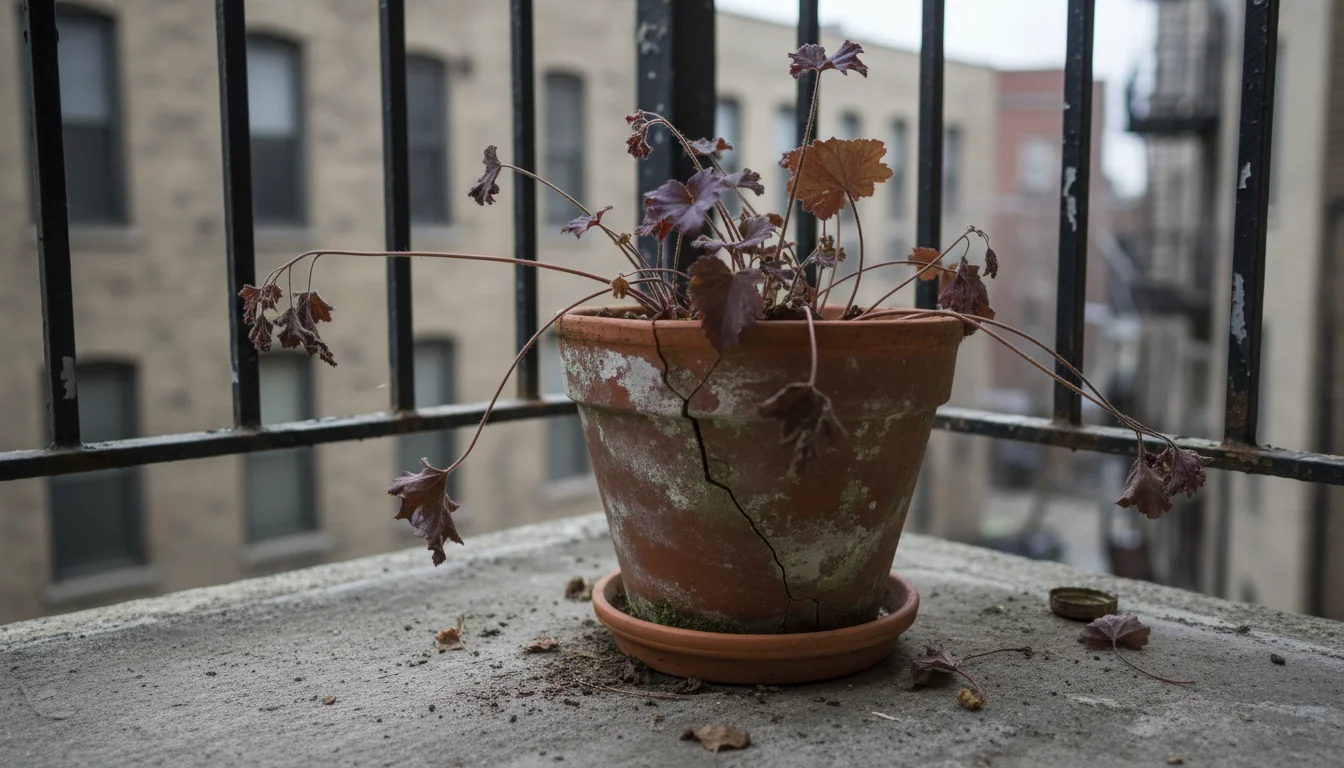
Troubleshooting Common Heuchera Issues in Pots
While Heuchera are generally robust, you might encounter a few common issues, especially when growing them in containers. Knowing how to diagnose and address these problems helps you keep your “heuchera in containers” healthy and vibrant.
- Leggy Growth and Fading Color:
- Symptom: Stems appear stretched out, and the plant loses its compact, mounding shape. Foliage colors might appear duller than expected.
- Cause: Often, this indicates insufficient light. While many Heuchera tolerate shade, too much deep shade can cause them to stretch towards light. For some varieties, insufficient light also prevents the full development of their vibrant “fall foliage plants” color.
- Solution: Move your container to a location with more bright, indirect light or morning sun. If the plant is very leggy, you might consider dividing and replanting the crown to encourage new, compact growth.
- Scorched or Brown Edges on Leaves:
- Symptom: Leaves appear burned, crispy, or have brown edges, particularly in summer.
- Cause: Too much direct sun, especially hot afternoon sun, causes leaf scorch. This is common in containers, as the roots also heat up faster. Underwatering can exacerbate this issue.
- Solution: Relocate the pot to a shadier spot, providing protection from intense afternoon sun. Ensure consistent watering, especially during hot, dry periods.
- Yellowing Leaves:
- Symptom: Leaves turn yellow, often starting from the bottom of the plant.
- Cause: This can indicate either overwatering or underwatering. Overwatering leads to root rot, preventing roots from absorbing nutrients, while underwatering causes stress and nutrient deficiency. Older leaves naturally yellow and drop as part of the plant’s life cycle.
- Solution: Check soil moisture. If it feels waterlogged, reduce watering frequency and ensure excellent drainage. If the soil is consistently dry, increase watering. Remove any yellowed leaves to improve the plant’s appearance and direct energy to new growth.
- Crown Rot:
- Symptom: The center of the plant becomes mushy, black, and eventually collapses. Leaves wilt and die despite seemingly adequate water.
- Cause: This is a severe fungal disease caused by consistently wet soil around the plant’s crown (where stems meet roots). Planting too deep also contributes. Poor drainage is a major culprit.
- Solution: Unfortunately, severely affected plants rarely recover. Prevention is key: ensure excellent drainage, plant with the crown at or slightly above the soil line, and avoid overwatering. If caught early, you might try repotting in fresh, well-draining soil after carefully removing any affected parts of the crown.
- Heaving in Winter:
- Symptom: The plant’s crown lifts out of the soil during winter.
- Cause: Repeated freezing and thawing of the soil causes it to expand and contract, pushing the plant upwards.
- Solution: Gently push the plant back down into the soil. Apply a layer of mulch over the soil surface in fall to insulate the crown and help prevent heaving. This is part of essential “heuchera winter care in pots.”
Regular observation helps you catch these issues early. By understanding the common signs and applying appropriate solutions, you maintain healthy, beautiful “coral bells care” in your containers.
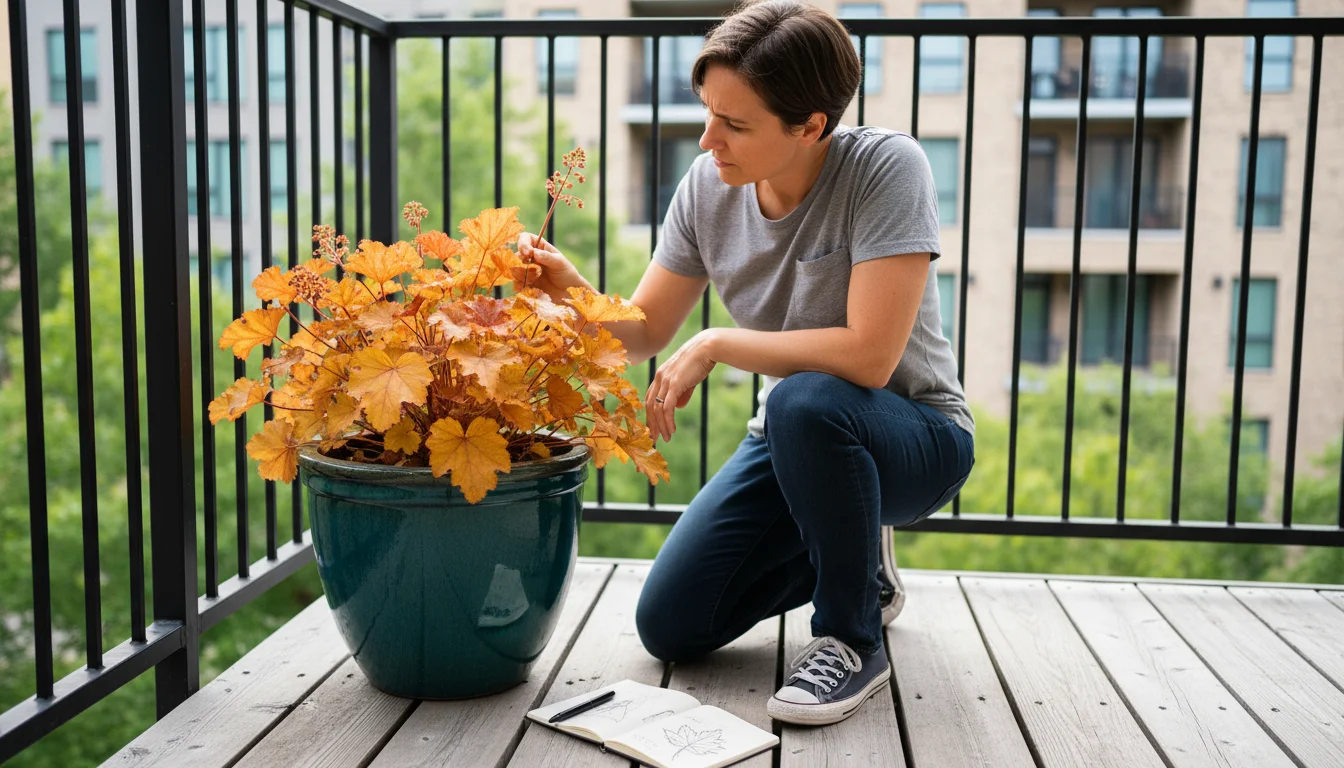
Frequently Asked Questions
Can Heuchera survive winter in pots in cold climates?
Yes, with proper “heuchera winter care in pots.” You need to protect the roots from extreme cold. Move pots to a sheltered, unheated area like a garage or porch, or insulate them with burlap or bubble wrap. Ensure soil stays only slightly moist.
How often should I water Heuchera in containers?
Water your “heuchera in containers” when the top inch of soil feels dry to the touch. This could be every few days in hot, dry weather, or less frequently in cooler conditions. Always ensure good drainage to prevent root rot.
Are Coral Bells considered “low light plants for fall containers?”
Many varieties of Heuchera tolerate and even thrive in partial to full shade, making them excellent “low light plants for fall containers.” While some varieties can handle more sun, especially with consistent moisture, most benefit from protection from intense afternoon sun to prevent leaf scorching.
Do I need to fertilize my Heuchera in pots?
Heuchera are not heavy feeders. For “coral bells care” in containers, a light application of a balanced liquid fertilizer in spring is usually sufficient. Over-fertilizing can lead to leggy growth and reduced foliage color, so less is often more.
What are the best “fall foliage plants” to pair with Heuchera?
Heuchera’s vibrant foliage makes it a fantastic partner for other “fall foliage plants” like ornamental grasses for vertical interest, pansies for early cool-season color, small evergreen conifers for structure, or even cyclamen for delicate blooms. Choose plants with contrasting textures or complementary colors to enhance your container display.
Heuchera offers an unmatched combination of beauty, resilience, and multi-season appeal for fall containers. By choosing Heuchera, you move beyond the temporary allure of traditional annuals and embrace a plant that provides lasting impact with minimal effort. Its incredible range of foliage colors and textures transforms your small garden spaces into vibrant, ever-changing showcases from fall through winter and back into spring. Embrace this unsung hero, and you will discover the enduring joy of a truly low-maintenance, high-impact perennial in your container garden.
For trustworthy gardening information, visit:
Mississippi State University Extension — Lawn & Garden, Arkansas Extension — Yard & Garden, Kansas State University Extension — Horticulture, Oklahoma State University Extension — Lawn & Garden and Tennessee Extension — Gardening. These organizations provide expert, research-based advice for gardeners at all levels.
Disclaimer: This article is for informational purposes only and is not a substitute for professional gardening advice. Always consult local extension services or horticulture experts for region-specific guidance.
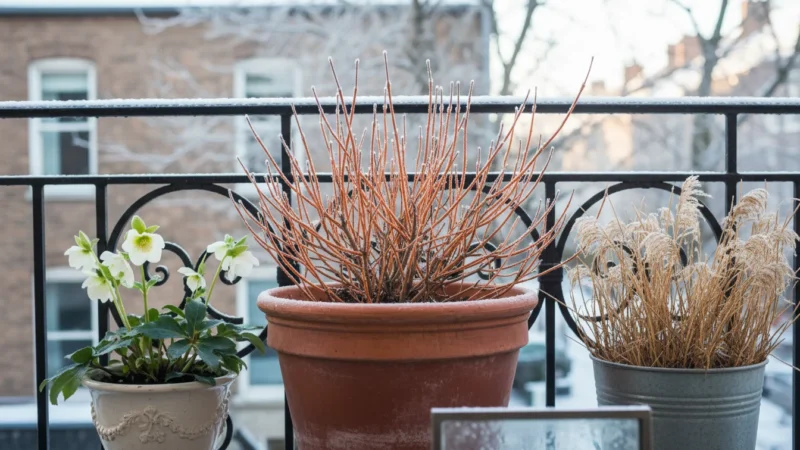
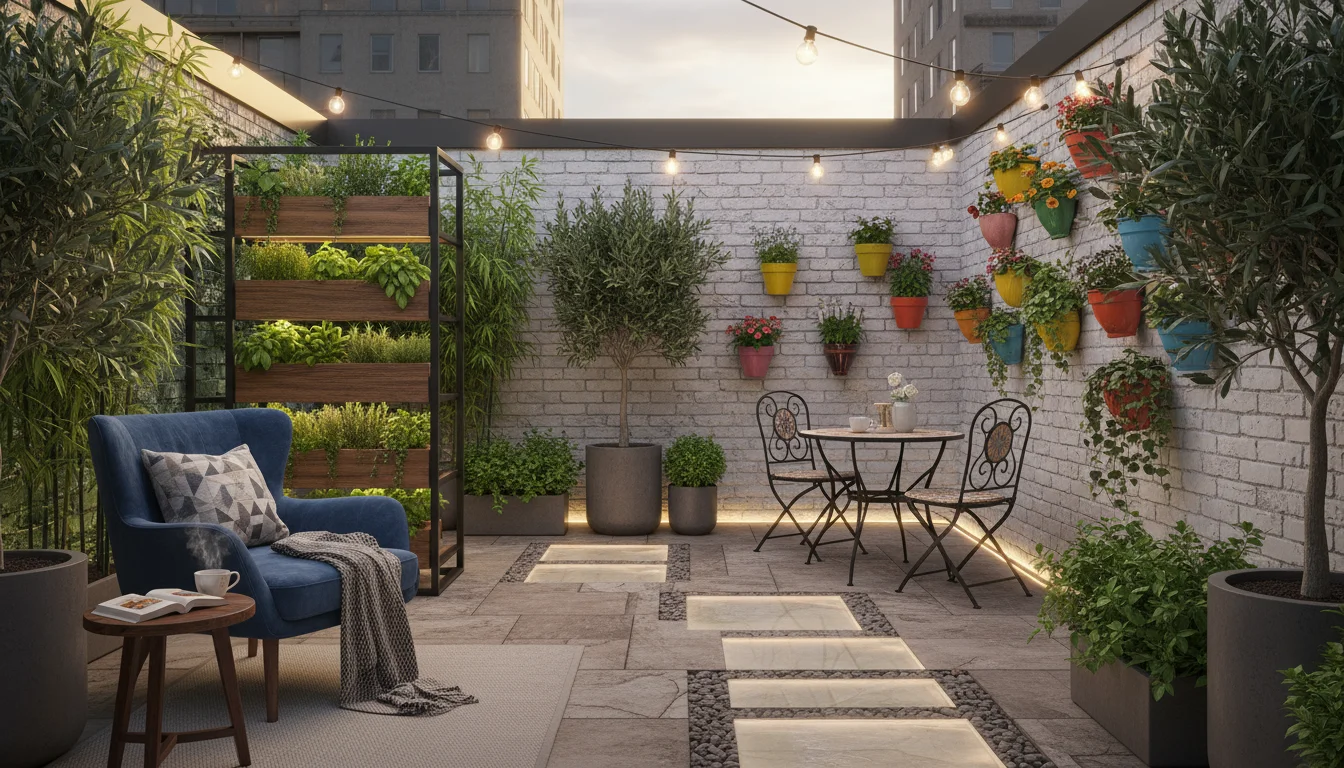
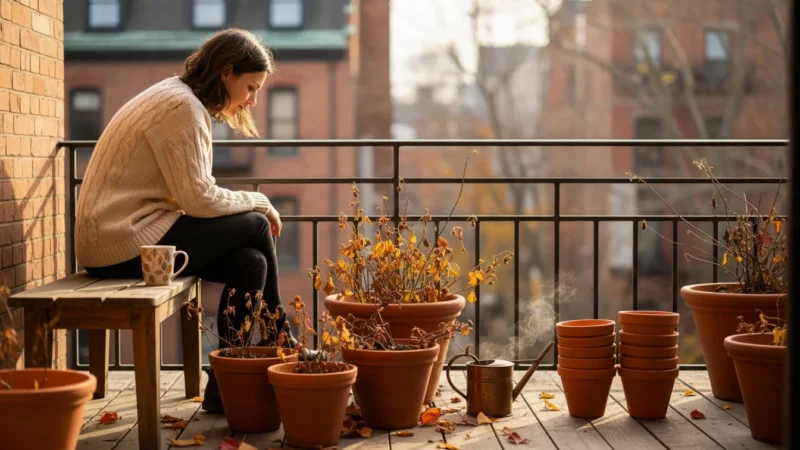

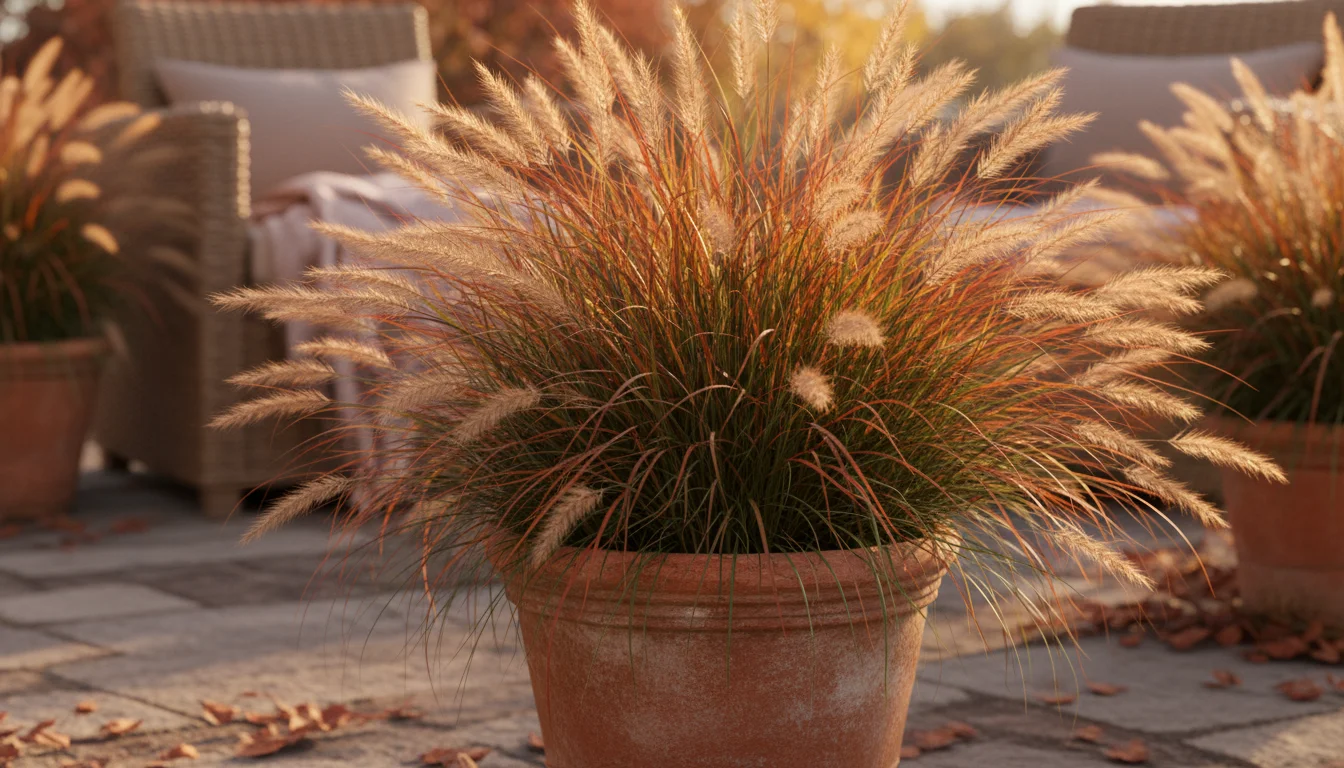
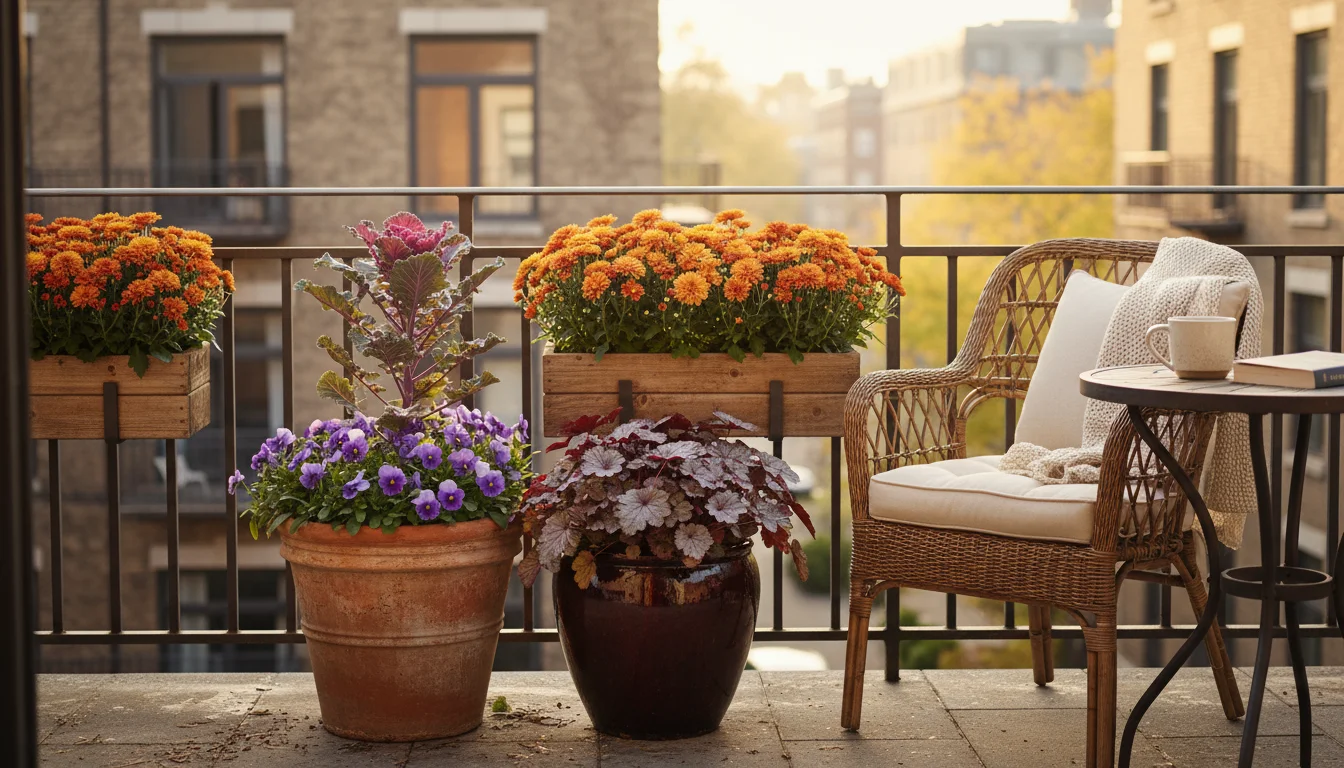
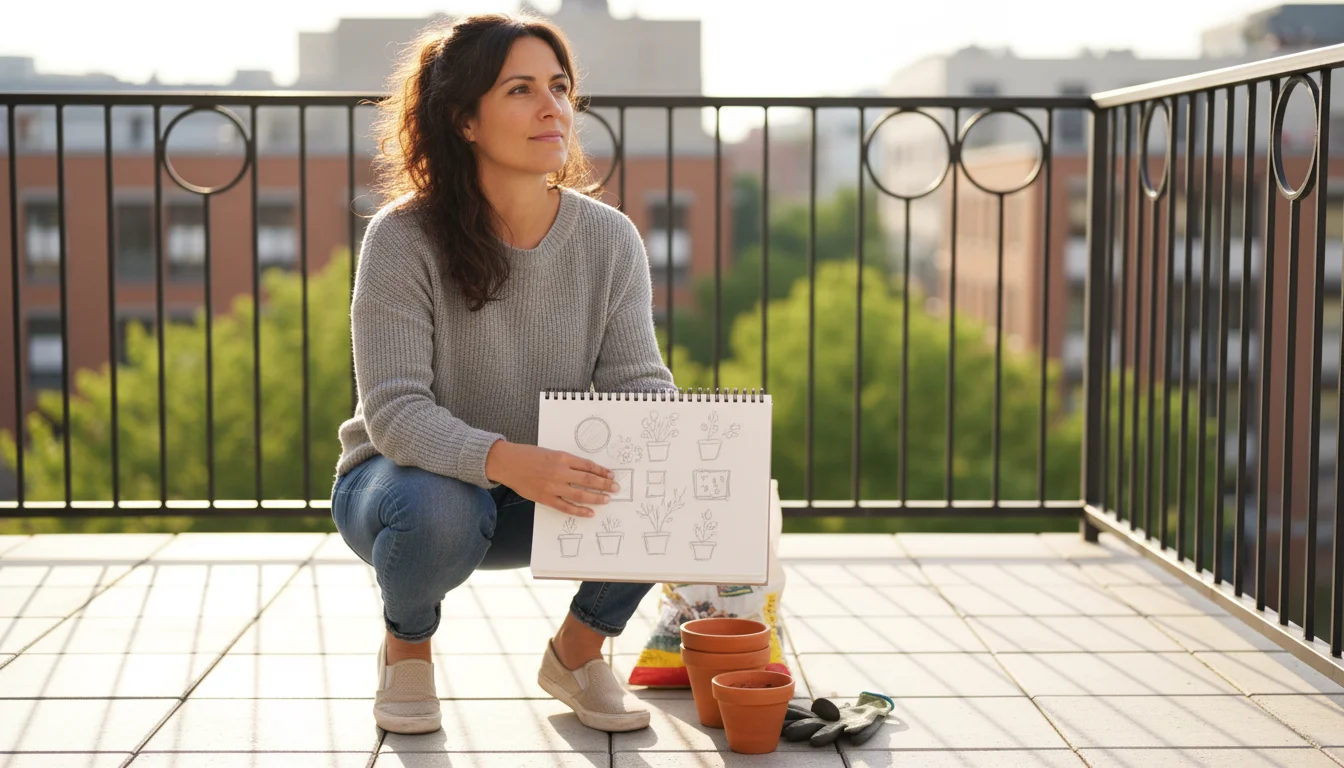
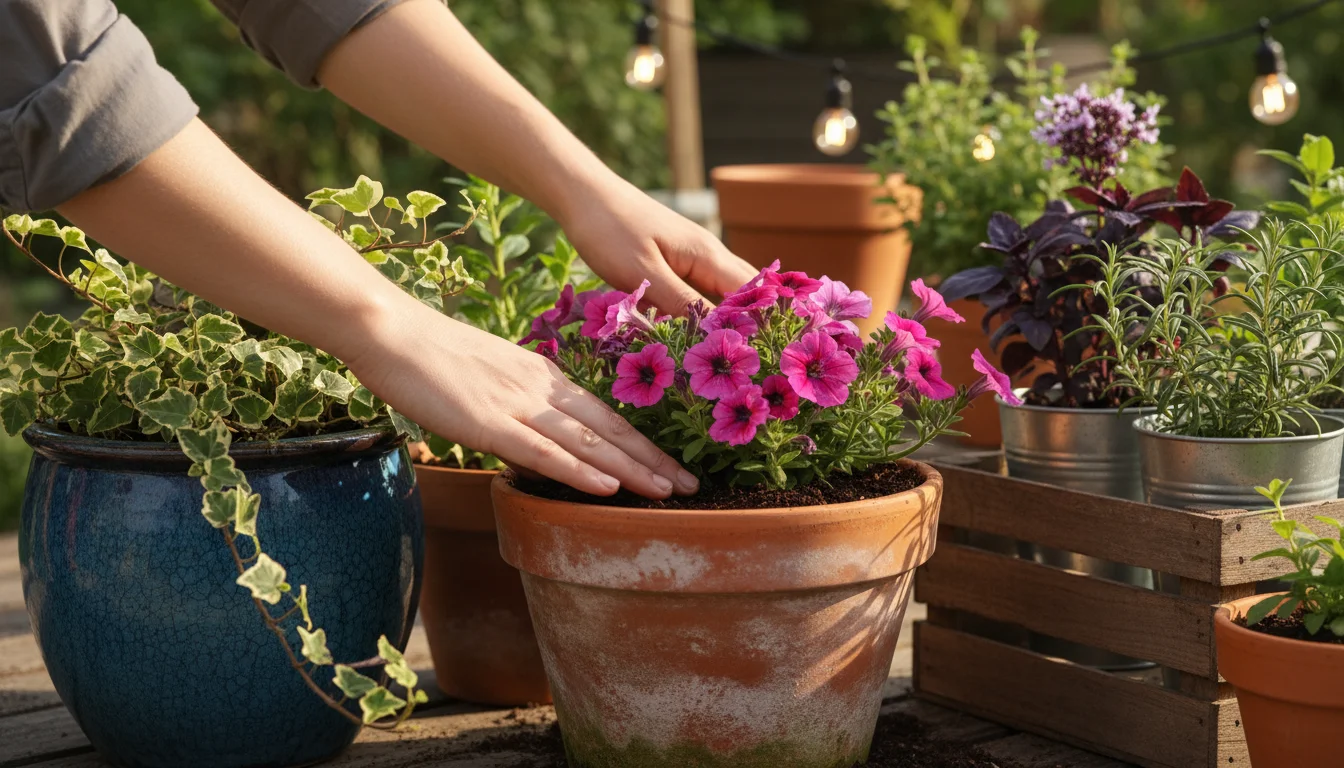

Leave a Reply